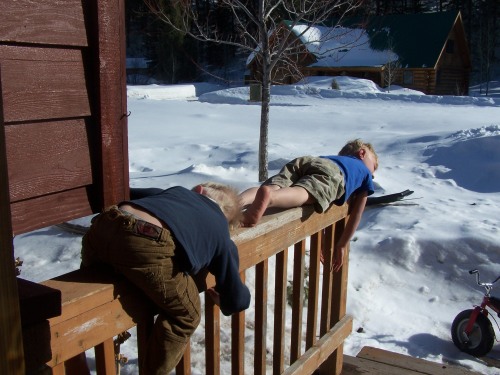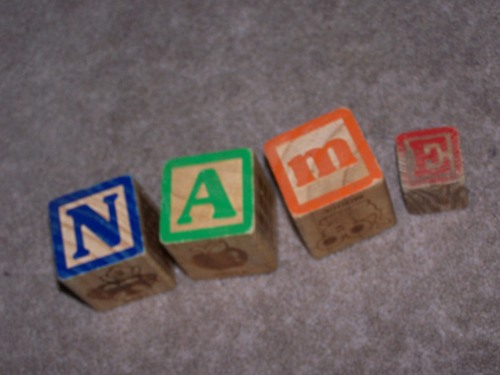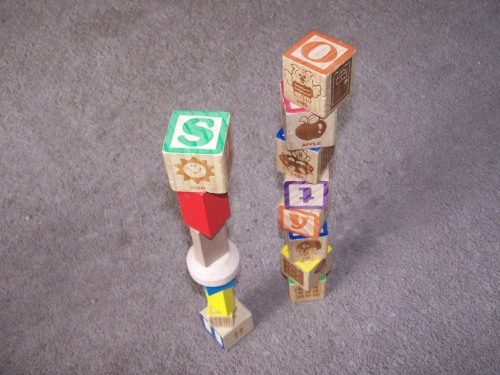
The sleeves are finished, the sweater has been sewn together and now the front edging is going on… and I have another idea…
Daniel is sitting beside me, working on his math. I am looooving this work book I found for him, made by Kumon.
Posted in home schooling, knitting, tagged home schooling, knitting on September 3, 2009| Leave a Comment »

The sleeves are finished, the sweater has been sewn together and now the front edging is going on… and I have another idea…
Daniel is sitting beside me, working on his math. I am looooving this work book I found for him, made by Kumon.
Posted in winter, tagged animals, ermine, home schooling on March 27, 2009| Leave a Comment »
This morning the kids read about Ermine, a member of the Mustelidae family, and realized that the weasels they have been seeing are Ermine!
The ones we have here are not often seen, but traces of them are found frequently… Footsteps on the back deck and around the perimeter of the house. I have never had any sign of them in the buildings, though, and none have turned up in any of our traps. They can grow up to 12″ long, but most that we have seen are about 7″ long.
Ermine are brown in the spring and summer but white in the winter. They feed off of small animals such as rabbits and rats. It seems, we could use a few more of these, as the dog killed another rat this week. The good news is that they have 3-13 babies each spring.
According to Wikipedia, they are territorial, and only one of each sex is likely to be found in any given location.
Image found here.
Posted in the seasons, winter, tagged children, home schooling, knitting, snow, winter on March 12, 2009| Leave a Comment »

Warm temperatures greeted us yesterday afternoon, and we revelled in them. I think it was about 40 degrees Fahrenheit. Oh, yes, chilly still, but not so cold that we didn’t enjoy some school on the front steps, and the bikes have been dug out!
If this weather continues, I will be planning my garden, knowing full well that it will be at least two months before we can till the soil. The town cop will be waving as he drives by while I sit on the porch, knitting — despite the snow!
Are you enjoying spring?
Posted in home schooling, tagged a month of school, home schooling, teaching tips on March 10, 2009| Leave a Comment »
* Taken from “Home Style Teaching”, by Raymond & Dorothy Moore.
Posted in home schooling, tagged a month of school, home schooling, teaching tips on March 6, 2009| Leave a Comment »
* Taken from “Home Style Teaching”, by Raymond & Dorothy Moore.
Posted in home schooling, tagged a month of school, home schooling, teaching tips on March 4, 2009| Leave a Comment »
* Taken from “Home Style Teaching”, by Raymond & Dorothy Moore.
Posted in home schooling, tagged a month of school, home schooling, teaching tips on March 2, 2009| Leave a Comment »
* Taken from “Home Style Teaching”, by Raymond & Dorothy Moore.
Posted in home schooling, tagged a month of school, children, family, home schooling on February 23, 2009| 1 Comment »
Picture found here.

Play is a very important part of a child’s life. Montessori defined play as a child’s work. Whatever a child is learning or thinking on, he will express through play.
When teaching something new, do not expect a child to start acting it out immediately. Play comes when a child has integrated the information into his being. For a young child, integration can take two weeks. For an older child, accustomed to being taught, the time is reduced; but, even an adult needs half an hour to integrate a new thought or idea.
One afternoon, about a year ago, I heard the boys running up and down the hallway. Thunk. Thunk. Thunk. Thunk. Up and down, up and down they ran.
There was also a strange grunting/chanting sound emitting from their mouths. A sound that was not wholly human…
I went to investigate, and found the two oldest giving the next two piggy-back rides, up and down the hallway, stopping occasionally to throw their limp brothers onto the couch, and pretend to feed them. It was very strange, indeed.
Finally they were ready for more. They began to ask for more information…
After watching them run, for what seemed like quite a while, I asked what they were doing. “An Orc run,” was the only answer I received, as they trotted past me with their brothers on their backs. Big flatfooted steps they took, shaking the house as they went.
Once the concept had worked its way into their understanding, they played “Orc Run” to its full. They played until their minds could wrap around the concept of strange warriors. Warriors who could run for three days, without tiring.
What in the world? “An orc run,” they had said.
Oh! Orcs!
They had watched “The Lord of the Rings” with their dad, about a month earlier. The concept of Orcs had been brand new to them then, and they had made no mention of them, except to refer to them as “The bad guys,” when talking of the battles.
Now the thoughts had come to some form of maturity, and they had need to act their understanding out. Their first encounter with Orcs had been the “Orc Run” when Merrie and Pippin had been carried off… so there they where, pretending their younger brothers were Hobbits, and they were Orcs…
Thunk. Thunk. Thunk. Thunk… On and on and on they went.
They did a similar thing when they learned that the sun did not just disappear in the evening, to reappear in the morning. That it was always daytime somewhere…
They set their playthings on a table, and stationed a ball for the sun. The “sun” would move throughout the day, and at night it would be placed under the table.
Play: Exploring their understanding.
Posted in home schooling, tagged a month of school, books, children, family, home schooling, reading on February 11, 2009| Leave a Comment »

What is in a name? Parents agonize over what to call their little one, long before that one is born. Children spend hours writing their name again and again. Teenagers and lovers write page after page of their crushes name.
One’s name is so connected with one’s identity, it is hard to seperate the two.
Children are naturally egotistical and self centered. This is not inherently bad. It is all they understand. Their perspective comes from what they have learned about the world, as they have seen it. We never fully outgrow this. Their favorite subject is ME. Understanding this, it makes sense to begin teaching them something that they have a vested interest in: Their name.
Spell your child’s name out for him or her. Teach him the letters. Teach her the sounds. Show your child the upper and lower case letters. Point out the vowels and the concenents. Teach them the vocabulary of reading, based on a subject they are deeply interested in.
Once your child can recognize the letters in his or her name, they will be ready for more. Find other names they have a deep interest in: Mom, Dad, their siblings, the family pets, the neighbors dog… maybe their love is dinosaurs. Spell out those names!
Label objects in the house. The door, the trash can, the stove, refrigerator, and cupboard. The plant and the mirror. All need a label. These labels can be made with 3×5 cards and a marker. Tape them on, and let the child ask about them. If they show no interest, point them out. When they have been up a few days, and you know your child has had adequate exposure, take two down that are very different, and ask your child to put them on the appropriate object. I bet your child can figure it out.
When teaching reading, never forget to actually read to your child. Read them books of every sort! Picture stories and chapter books are equally interesting to a preschool/kindergarten age child. The first chapter book we read was The Tale of Despereaux: Being the Story of a Mouse, a Princess, Some Soup and a Spool of Thread. My boys absolutely loved it, and we have read it several times. The first chapter book my mom read to me was Little House in the Big Woods. It was the first chapter book I read to myself.
Posted in home schooling, tagged a month of school, child training, children, home schooling, how-to on February 10, 2009| Leave a Comment »

Blocks: There are so many things you can do with them!
A simple science lesson is built into every single one. If your child asks about the sun picture, take time to point out the sunshine in the sky, and talk about all the things the sun does. If your child likes the owl, read a book about an owl with him. Talk about balance, as he builds. Give him the vocabulary to communicate, as he works. Talk about shape and size, texture and weight.
Talk about how blocks are made, and where they come from. Show your children how you built houses or bridges, when you were a child.
Get down on their level, and play with them. Lear with them. Teach them. Don’t be afraid to introduce something new. They may not learn it all. You may not know it all, but together you can learn and grow.